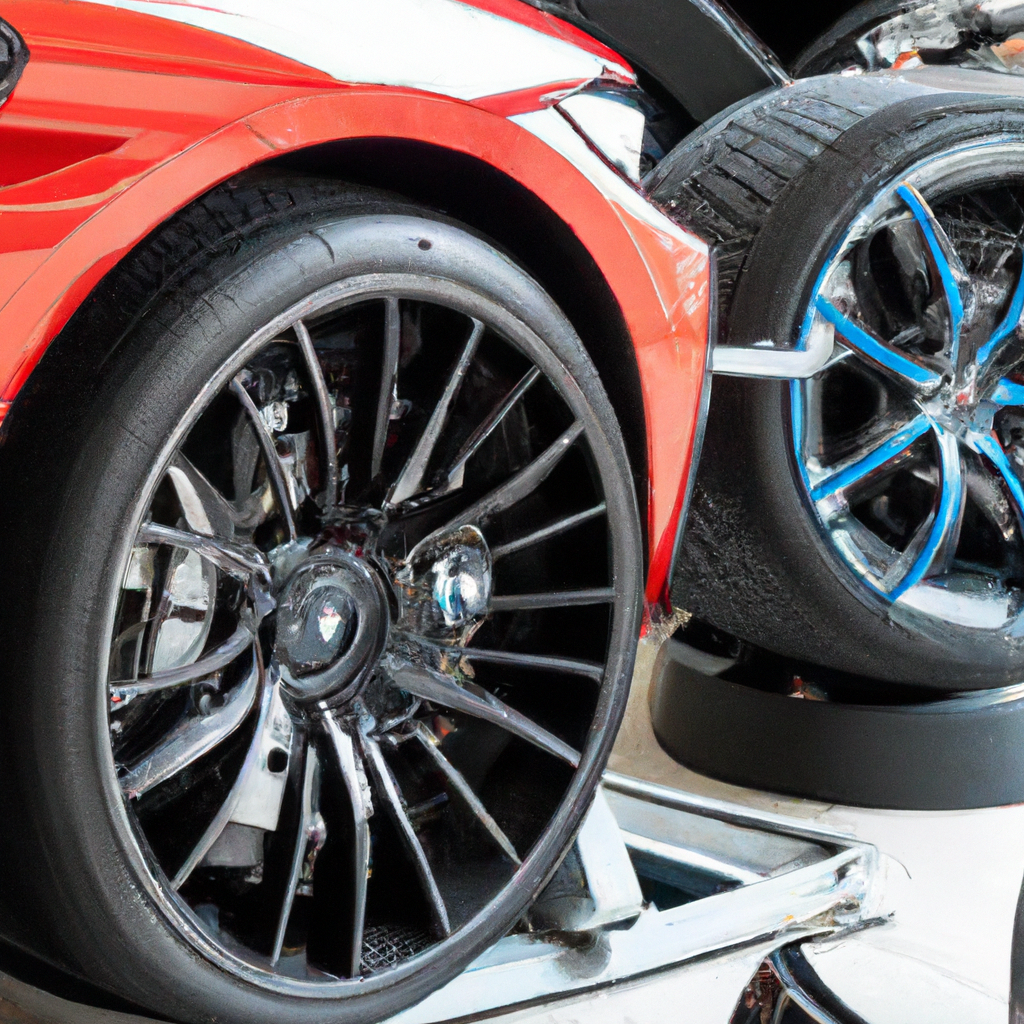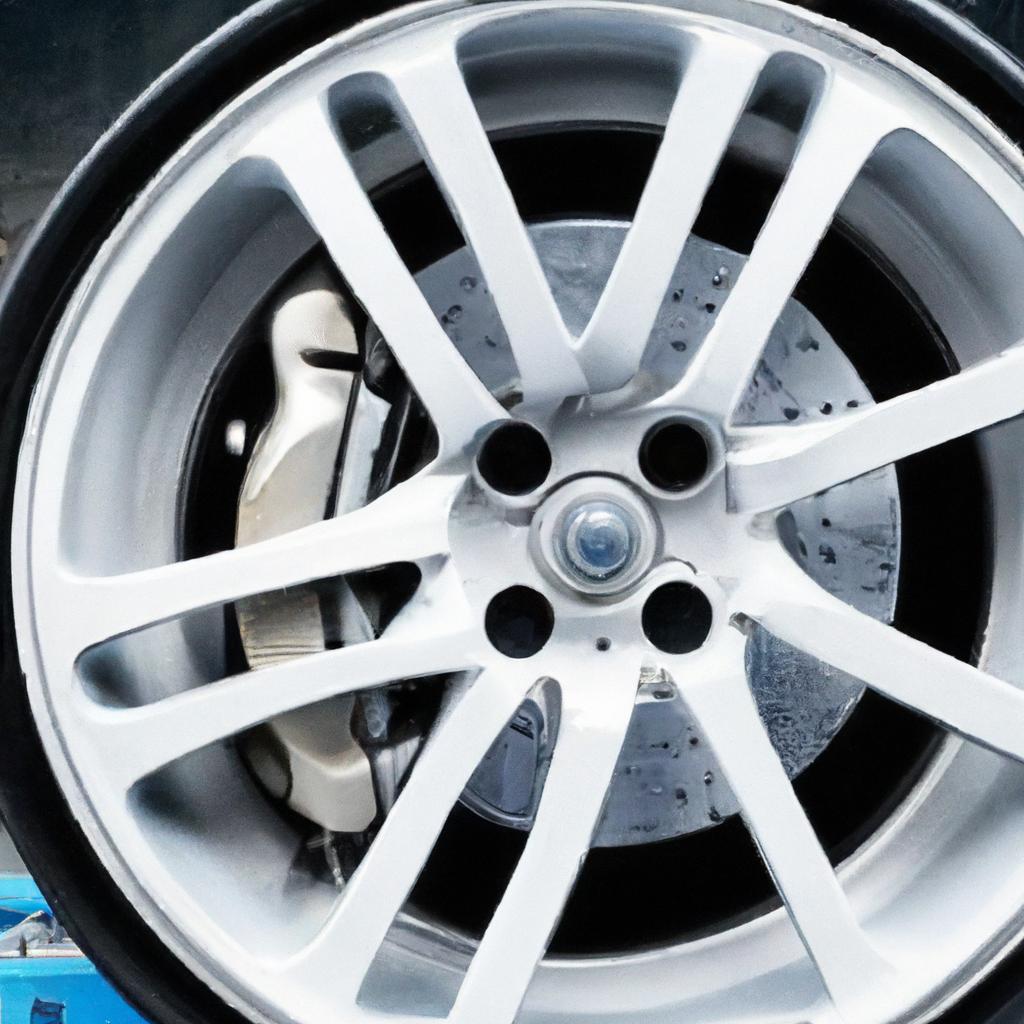If you’ve ever had the pleasure of owning a car with alloy wheels, you’ll know just how important it is to keep them looking clean and shiny. But with so many different cleaning methods out there, it can be challenging to know which one is truly the best. In this article, we’ll explore various techniques that will have your alloy wheels sparkling in no time, giving your car that extra touch of elegance and sophistication it deserves. So, grab your cleaning supplies, and let’s dive into the world of alloy wheel cleaning!

Choosing the Right Cleaning Products
Using pH-Neutral Wheel Cleaners
When it comes to cleaning your alloy wheels, using pH-neutral wheel cleaners is key. These cleaners are specifically formulated to be gentle yet effective, so they won’t damage or harm the delicate finish of your wheels. The pH-neutral formula ensures that it won’t react negatively with the metal or any protective coatings that are on the surface of the wheels. This makes it a safe and effective choice for regular maintenance and cleaning.
Avoiding Acidic Wheel Cleaners
While some wheel cleaners may claim to be powerful and effective, it’s important to steer clear of acidic cleaners when it comes to cleaning your alloy wheels. Acidic cleaners can cause significant damage to the metal, leading to corrosion, discoloration, and even pitting. The acidic nature of these cleaners can strip away any protective coatings that may be on the wheels, leaving them vulnerable to further damage. So, it’s best to avoid these cleaners altogether and opt for pH-neutral alternatives.
Considering Aluminum-Safe Cleaners
If your alloy wheels are made of aluminum, it’s important to choose a cleaner specifically formulated for use on aluminum surfaces. Aluminum-safe cleaners are designed to effectively remove dirt, grime, and brake dust without causing any harm to the aluminum. These cleaners are typically pH-neutral and will help maintain the integrity and appearance of your aluminum wheels. So, keep in mind the material of your wheels when selecting a cleaning product to ensure optimal results.
Gathering the Necessary Tools and Materials
Wheel Brush
A wheel brush is an essential tool for cleaning your alloy wheels. Look for a brush with soft bristles that won’t scratch or damage the surface of your wheels. A wheel brush with a long handle can also make it easier to clean hard-to-reach areas. This will help ensure that you can thoroughly clean the entirety of your wheels and remove any dirt or grime that may be hiding in crevices or between spokes.
Microfiber Cloths
Microfiber cloths are a must-have when it comes to cleaning your alloy wheels. These soft and absorbent cloths are perfect for wiping away excess water, drying the wheels, and polishing them to a high shine. The fine fibers of microfiber cloths are gentle on the wheels and won’t leave behind any lint or scratches. Make sure to have a few clean microfiber cloths on hand during the cleaning process to achieve the best results.
Bucket of Water
Having a bucket of water handy is crucial for rinsing off dirt and debris from your wheels. Fill the bucket with clean water before you start the cleaning process. This will allow you to easily dip your wheel brush or microfiber cloth into the water to remove excess dirt and grime. Having a bucket of water nearby will make the cleaning process more efficient and ensure that you can thoroughly rinse your wheels.
Spray Bottle
A spray bottle is a convenient tool to have when cleaning your alloy wheels. Fill it with a diluted solution of wheel cleaner and water to create an easy-to-use spray. This will allow you to evenly distribute the wheel cleaner onto the surface of your wheels, making it easier to scrub away dirt and grime. The spray bottle also ensures that you don’t use too much product, helping you save on cleaner and avoid any potential oversaturation.
Wheel Cleaner
Choosing the right wheel cleaner is essential for achieving clean and shiny alloy wheels. As mentioned earlier, opt for a pH-neutral cleaner that is safe for use on alloy wheels. Look for a cleaner specifically formulated for your type of wheels, whether they are aluminum, chrome, or another material. Read the instructions on the cleaner carefully and follow the recommended dilution ratios to ensure the best results.
Protective Gloves
When using cleaning chemicals, it’s important to protect your hands with a pair of protective gloves. Some wheel cleaners can contain strong chemicals that may irritate or dry out your skin. By wearing gloves, you not only protect your hands from potential harm but also maintain the cleanliness of your wheels. Plus, it’s always better to be safe than sorry when it comes to working with cleaning products.
Protective Eyewear
While it may not be an obvious choice, wearing protective eyewear when cleaning your alloy wheels is a wise decision. When scrubbing or applying cleaning solutions, there is a chance that dirt, debris, or cleaning product may splash back and potentially hurt your eyes. By wearing protective eyewear, you ensure your safety and reduce the risk of any accidents or injuries.
Preparing the Wheels for Cleaning
Cooling the Wheels
Before diving into the actual cleaning process, it’s important to let your wheels cool down if they have recently been in use. Hot wheels can make the cleaning process more challenging and the cleaning products may not work as effectively. Allow ample time for your wheels to cool off before starting to ensure the best cleaning results.
Removing Hubcaps or Wheel Covers
If your alloy wheels have hubcaps or wheel covers, it’s essential to remove them before cleaning. Hubcaps and wheel covers can accumulate dirt and grime underneath, which can affect the overall cleanliness of your wheels. Carefully remove them using the appropriate tools or by following the instructions provided by the manufacturer. Once removed, you’ll have full access to the entire wheel surface, making it easier to clean thoroughly.
Rinsing with Water
Start the cleaning process by thoroughly rinsing your wheels with water. This step helps remove any loose dirt or debris from the surface, making it easier to clean. Use a hose or a bucket of water and a sponge to rinse the wheels, ensuring that you cover all areas. Pay extra attention to hard-to-reach areas and the backside of the wheels, as they tend to accumulate more grime.
Cleaning the Alloy Wheels
Spraying the Wheel Cleaner
Once the wheels have been rinsed, it’s time to apply the wheel cleaner. Using the spray bottle filled with the diluted cleaner, evenly spray the solution onto the surface of each wheel. Make sure to cover the entire wheel, including the spokes, rims, and any other areas that may accumulate dirt. The wheel cleaner will help break down any stubborn dirt, grime, or brake dust, making it easier to remove during the scrubbing process.
Scrubbing with a Wheel Brush
After applying the wheel cleaner, take your wheel brush and start scrubbing the surface of the wheels. Use gentle yet firm pressure to effectively remove any dirt or grime. Pay attention to the spokes and other intricate areas where dirt can accumulate. The soft bristles of the brush will help dislodge stubborn particles without scratching the surface of the wheels. Make sure to scrub all areas thoroughly for optimal cleaning.
Cleaning Hard-to-Reach Areas
Some areas of your alloy wheels can be challenging to clean, such as behind the spokes or in small crevices. To effectively clean these hard-to-reach areas, you can use a smaller brush or a toothbrush. Apply some wheel cleaner to the brush and carefully scrub these tight spaces. The bristles will help dislodge any dirt or grime, ensuring a thorough cleaning. Take your time and be patient, as these areas may require a bit more effort to get them sparkling clean.
Rinsing Thoroughly
Once you have thoroughly scrubbed and cleaned all areas of your alloy wheels, it’s time to rinse them off. Use clean water and a hose or bucket to rinse away any remaining wheel cleaner and lingering dirt or debris. Make sure to rinse each wheel individually, paying attention to hard-to-reach areas. Take your time to ensure that all traces of the cleaner and dirt are completely washed away.

Removing Stubborn Stains or Brake Dust
Using Non-Abrasive Cleaners
Sometimes, your alloy wheels may have stubborn stains or brake dust that is difficult to remove with regular cleaning methods. In such cases, using non-abrasive cleaners can be a game-changer. Non-abrasive cleaners are specifically designed to target tough stains while being gentle on the wheels. Apply the cleaner directly to the stain, let it sit for a few minutes, and then scrub with a non-abrasive brush or cloth. This method should help remove even the most stubborn stains without causing any damage to the wheels.
Applying Paste or Gel Cleaners
Another option for tackling stubborn stains or brake dust is to use paste or gel cleaners. These cleaners are thicker in consistency and can be applied directly to the affected areas. Apply a small amount of the paste or gel onto the stain and let it sit for a few minutes. Then, use a soft cloth or brush to scrub the area gently. The paste or gel will work to break down the stains, making it easier to remove them from the surface of your alloy wheels.
Scratching Stubborn Dirt with a Wheel Woolie
If you are dealing with particularly stubborn dirt or grime that is hard to remove, using a wheel woolie can be a great solution. A wheel woolie is a specialized brush made with soft wool fibers that are safe for use on alloy wheels. Dip the wheel woolie into a bucket of water or diluted wheel cleaner and use it to scrub away the tough dirt or grime. The wool fibers are gentle on the surface of the wheels, minimizing the risk of scratching while still offering excellent cleaning power.
Using a Clay Bar
For the ultimate deep clean and to remove any embedded contaminants on your alloy wheels, using a clay bar can be incredibly beneficial. Clay bars are designed to safely lift bonded contaminants from the surface of the wheels, such as brake dust, tar, or stubborn dirt. To use a clay bar, lubricate the surface of the wheels with a clay lubricant or a diluted solution of car shampoo. Then, gently glide the clay bar over the wheel’s surface, applying light pressure. The clay bar will pick up any embedded contaminants, leaving your wheels smooth, clean, and ready for further protection or polishing.
Drying the Wheels
Using Microfiber Cloths
Once you have finished cleaning your alloy wheels, it’s important to dry them thoroughly to prevent water spots and maintain their shine. Microfiber cloths are perfect for this task as they are absorbent and soft, ensuring no lint or scratches are left behind. Use a clean microfiber cloth to carefully dry each wheel, paying attention to all areas. Wipe the entire wheel surface until it is completely dry, ensuring there is no moisture left.
Air Drying
Alternatively, you can let your alloy wheels air dry after cleaning. This method requires more time, but it can be equally effective. Simply leave the wheels in a well-ventilated area, away from direct sunlight or excessive heat, and let them dry naturally. Keep in mind that air drying may take longer, especially if the weather conditions are humid. However, when done correctly, this method can still result in clean, dry, and shiny wheels.

Polishing the Alloy Wheels
Choosing the Right Wheel Polish
Polishing your alloy wheels can enhance their appearance, restore shine, and provide an extra layer of protection. When selecting a wheel polish, look for one that is specifically formulated for use on alloy wheels. Consider whether the polish is suitable for the type of finish your wheels have – be it chrome, painted, or clear-coated. It’s also important to choose a polish that is easy to apply and remove, ensuring a hassle-free polishing process.
Applying Polish with a Microfiber Cloth or Applicator Pad
To apply the wheel polish, use a clean microfiber cloth or an applicator pad. Apply a small amount of polish onto the cloth or pad and gently work it into the wheel’s surface. Use circular motions to evenly distribute the polish, ensuring complete coverage. Take your time to polish each wheel thoroughly, paying attention to detail. Avoid applying too much pressure, as a light touch is usually sufficient to achieve the desired results.
Buffing the Wheels
After applying the polish, allow it to dry according to the manufacturer’s instructions. Once dry, use a clean microfiber cloth to buff the wheels and remove any excess polish. Buffing will help achieve a high shine and remove any remaining residue. Work in circular motions, applying a light pressure to bring out the luster of your wheels. Take your time and ensure that every wheel is buffed to perfection.
Protecting the Wheels
Applying a Wheel Sealant or Wax
To provide additional protection and maintain the shine of your alloy wheels, consider applying a wheel sealant or wax. Wheel sealants create a protective barrier on the surface of the wheels, shielding them from dirt, brake dust, and other contaminants. Apply the sealant or wax according to the manufacturer’s instructions, using a clean microfiber cloth or applicator pad. Spread the product evenly on the wheels and let it dry. Once dry, buff the wheels gently to reveal the protective shine.
Using a Wheel Coating
For long-lasting protection and enhanced durability, using a wheel coating can be an excellent choice. Wheel coatings create a strong barrier that helps repel dirt and grime, making cleaning your wheels easier in the future. Before applying the wheel coating, make sure your wheels are clean and dry. Follow the instructions provided with the coating, applying it evenly to the wheels using a microfiber cloth or applicator pad. Allow the coating to cure and dry according to the manufacturer’s guidance for optimal results.

Cleaning Wheels with Painted or Clear-Coated Surfaces
Avoiding Abrasive Cleaners or Brushes
If your alloy wheels have painted or clear-coated surfaces, it’s crucial to avoid using abrasive cleaners or brushes. These can cause scratches or damage to the delicate coating, compromising the appearance of your wheels. Instead, opt for milder cleaning solutions that are suitable for painted or clear-coated surfaces. Always read the labels on your cleaning products to ensure their compatibility with the specific type of wheels you have.
Using Soap and Water Solution
A gentle yet effective method for cleaning alloy wheels with painted or clear-coated surfaces is to use a soap and water solution. Mix a mild automotive shampoo or dish soap with water in a bucket or spray bottle. Apply the solution to the wheels using a soft sponge or cloth, working in circular motions. Rinse the wheels with clean water and dry them thoroughly to prevent water spots. Regularly cleaning your painted or clear-coated alloy wheels with soap and water solution will help maintain their appearance and protect the delicate coating.
Cleaning Regularly
To keep your alloy wheels looking their best, it’s important to clean them regularly. Regular cleaning helps prevent dirt, grime, and brake dust from building up and becoming more difficult to remove. By following a regular cleaning routine, you ensure that your alloy wheels stay in top condition and maintain their shine for years to come. So, make it a point to clean your wheels on a regular basis to enjoy their pristine appearance and extend their lifespan.
Conclusion
Cleaning your alloy wheels is not only about maintaining their appearance but also preserving their integrity and extending their lifespan. By following the right methods and using the appropriate cleaning products, you can effectively remove dirt, grime, and brake dust while keeping your wheels in pristine condition. Remember to choose pH-neutral wheel cleaners, gather the necessary tools and materials, and prepare your wheels for cleaning. Clean thoroughly, remove stubborn stains or brake dust, dry your wheels properly, and consider polishing and protecting them for long-lasting shine. Whether you have aluminum, chrome, painted, or clear-coated alloy wheels, there are specific cleaning methods suited to your needs. So, make the right choice, clean your alloy wheels regularly, and enjoy the ultimate shine on your prized vehicle accessories.


